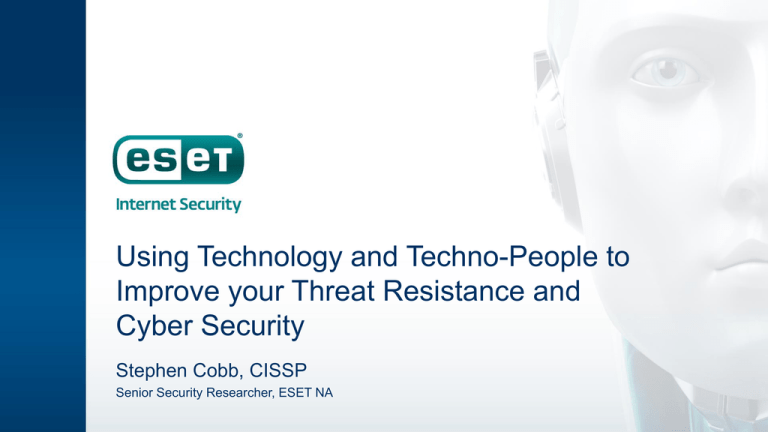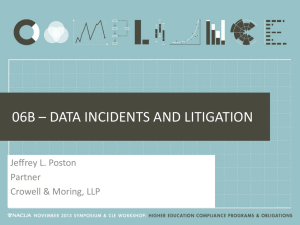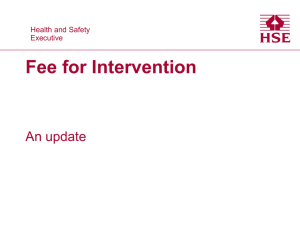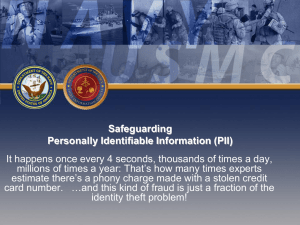CS-6 Using Technology and Techno-people to Improve your
advertisement

Using Technology and Techno-People to Improve your Threat Resistance and Cyber Security Stephen Cobb, CISSP Senior Security Researcher, ESET NA Protecting federal data systems • Requires: – technical and human elements – properly synchronized We have the technology • • • • • • Anti-malware Firewalls 2-factor authentication Encryption Network monitoring Filtering And the technology is getting smarter • Cloud-based reputation, signatures, big data • But technology is undermined when your workforce is not trained to play defense Waiting for technology alone to solve the data security problem? Dream on… Techno-people • • • • • Not everyone needs to be technical, but: We are all computer users Data security is everyone’s responsibility Everyone needs to understand the threats And the defensive strategies Today’s agenda • • • • • Scale of the problem Nature of our adversaries Information security’s 9 patterns Patterns applied to federal agencies How to improve the coordination of people and technology to address those patterns April 2014 GAO report • Information Security – Federal Agencies Need to Enhance Responses to Data Breaches • (GAO-14-487T) • A lot of work still to be done, across numerous agencies – Improve security – Improve breach response The scale of the problem • Information security incidents reported to US-CERT by all agencies • Number of incidents up • More data to defend? • Improved reporting? 61,214 48,562 41,776 42,854 29,999 2009 2010 2011 2012 2013 Exposure of PII is growing 25,566 • More incidents involving Personally Identifiable Information (PII) • Why? – Thriving black market for PII 22,156 15,584 13,028 10,481 • Impact – Seriously impacts individuals – Growing public displeasure – Heads may roll 2009 2010 2011 2012 2013 A federal PII breach example • July 2013, hackers get PII of 104,000+ people – From a DOE system • Social Security numbers, birth dates and locations, bank account numbers – Plus security questions and answers • DOE Inspector General: cost = $3.7 million – Assisting affected individuals and lost productivity What happens to the stolen data? • Sold to criminal enterprises – For identity theft, raiding bank accounts, buying luxury goods, laundering money • Lucrative scams like tax identity fraud The market for stolen data has matured All driven by proven business strategies An overwhelming problem? • Not if we analyze security incidents • 2014 Verizon Data Breach Investigation Report • 92% of incidents can categorized into 9 patterns – True for 100,000 incidents over 10 year period – True for 95% of breaches in the last 3 years The Big 9 • • • • • • • • • • Point-of-sale intrusions Web app attacks Insider/privilege misuse Physical theft and loss Miscellaneous errors Crimeware Payment card skimmers Denial of service Cyber-espionage Everything else Industry sectors not affected equally Just 4 patterns where victim industry = Public 2% 34% Miscellaneous Insider Misuse 19% Crimeware Theft/Loss 24% Everything Else 21% 2014 Verizon Data Breach Investigation Report Let’s count down the top 4 • • • • • Miscellaneous Insider and privilege misuse Crimeware Physical theft/loss Everything else Pattern #4: Physical theft and loss • Cause of 19% of public sector security incidents • It’s people! • Screen, educate, supervise • Reduce impact by using encryption Other 892 Laptop 308 Documents 140 Desktop 108 Flash drive 102 Other 39 Tapes 36 Database 11 2014 Verizon Data Breach Investigation Report Pattern #3: Crimeware • Accounts for 21% • It’s people abusing technology • Can be solved with the right antimalware strategy • Endpoint AND server scanning Web drive-by 43% Web download 38% Network propogation 6% Email attachment 5% Email link 4% Download by malware 2% Other 2% Remote injection 1% Unknown 1% Removable media 1% 2014 Verizon Data Breach Investigation Report Pattern #2: Insider and privilege misuse • 24% of incidents • Again it’s people! • Can be fixed! – Education – Awareness – Screening Cashier 23% End-user 17% Finance 13% Manager 13% Call center 9% Executive 7% Other 7% Developer 6% System admin 6% Auditor 1% 2014 Verizon Data Breach Investigation Report Pattern #1: Miscellaneous Errors • 34% of incidents • Human error! • Can be fixed! – Training – Awareness – Oversight Misdelivery 44% Publishing error 22% Disposal error 20% Misconfiguration 6% Malfunction 3% Programming error 3% Gaffe 1% Omission 1% Other 1% Maintenance error 0.5% 2014 Verizon Data Breach Investigation Report Strategy for doing better • Technologies and people working together • If they don’t you get: Target – – – – – Malware was detected Exfiltration detected But nobody reacted Training and awareness? Clearly lacking Security training and awareness • You need both, but what’s the difference? • Training – Ensure people at different levels of IT engagement have the knowledge they need • Awareness – Ensure all people at all levels know the threats and the defensive measures they must use Who gets trained? • Everyone, but not in the same way: – All-hands training – IT staff training – Security staff training How to deliver training • • • • • • • In person Online On paper In house Outside contractor Mix and match Be creative Incentives? • They work! – Drive engagement – Encourage compliance • But need reinforcement – Security in job descriptions – Evaluations – Rewards Use your internal organs • • • • • • Of communication! Newsletter Internal social media Physical posters Add to meeting agendas Email blasts How to do awareness • • • • Make it fun Make it relevant Leverage the news Remember: – Everyone now has a vested interested in staying current on threats to their/your data Awareness example: phish traps • Train on phishing • Send out a phishing message • Track responses • Report card and reeducation – No naming & shaming Awareness example: flash phish • Train on media scanning • Sprinkle USB/flash drives – Sample file/autorun • Track results – Inserted? Scanned? Reported? • Rewards or re-education – Again, avoid name+shame Resources to tap • • • • • • CompTIA ISSA SANS 2 (ISC) Vendors Websites Thank you! • Stephen Cobb • Stephen.cobb@eset.com • We Live Security • www.welivesecurity.com • Webinars • www.brighttalk.com/channel/1718 • Booth Number 826











